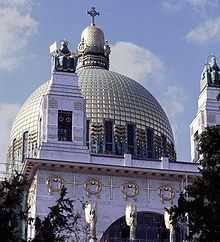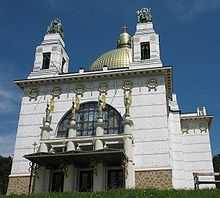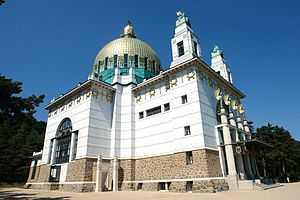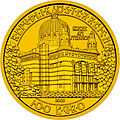Kirche am Steinhof
| Kirche am Steinhof | |
|---|---|
|
Kirche am Steinhof, Vienna, Austria | |
 Shown within Austria | |
| Basic information | |
| Location | Vienna, Austria |
| Geographic coordinates | 48°12′38″N 16°16′44″E / 48.2105°N 16.2788°ECoordinates: 48°12′38″N 16°16′44″E / 48.2105°N 16.2788°E |
| Affiliation | Catholic Church |
| Ecclesiastical or organizational status | Oratory |
| Website |
www |
| Architectural description | |
| Architect(s) | Otto Wagner |
| Architectural type | Church |
| Architectural style | Art Nouveau |
| Direction of façade | S |
| Groundbreaking | 1903 |
| Completed | 1907 |
| Construction cost | 575,000 krone |
| Capacity | 800 |
| Dome(s) | 1 |
| Materials | Carrara marble, copper |
Kirche am Steinhof, also called the Church of St. Leopold, is the Roman Catholic oratory of the Steinhof Psychiatric Hospital in Vienna, Austria. The building designed by Otto Wagner is considered one of the most important Art Nouveau churches in the world.
Description
The church, situated 310 metres (1,020 ft) above sea level, dominates and forms part of the Steinhof Psychiatric Hospital; previous official title was Niederösterreichische Landes-Heil- und Pflegeanstalt für Nerven- und Geisteskranke 'Am Steinhof' (Lower Austrian State Healing and Care Institution for the Neurologically and Mentally Sick, 'Am Steinhof'). It is located on a hillside (the Baumgartnerhöhe) below the Galitzinberg in the 14th Vienna district, Penzing. It has a separate status as part of the surrounding hospital and does not form part of the Archdiocese of Vienna.
Architecture
The church dedicated to Saint Leopold was built between 1903 and 1907 by the 63-year-old architect Otto Wagner, with mosaics and stained glass by Koloman Moser, and sculptural angels by Othmar Schimkowitz (1864–1947). The great majority of the other smaller details are the work of Otto Wagner himself. The statues on the two external towers represent Saint Leopold and Saint Severin (l. & r. respectively: they are the two patron saints of Lower Austria) and are the work of the Viennese sculptor Richard Luksch (1872–1936).
Unusually the church lies on a North-South axis, at the centre-top of the hospital complex. Otto Wagner incorporated numerous features specifically related to its function within an asylum: e.g. there are very few sharp edges, and most corners are rounded; almost no crosses are visible; the priest's area is potentially entirely separate from the patients'; access to the pulpit is only from the vestry; emergency exits are built into the side walls in case a patient needed to be speedily removed; continuously flowing water replaced holy water stoups at the entrance; there were separate entrances for male and female patients; confessionals were more open than is customary. There were toilet facilities easily accessible within the church in case of patient need. Originally the pews were of different widths to accommodate different categories of patient: calm / restless / disturbed (the latter needing more space). The floor is raked as in a theatre though not as steeply; the fall from entrance to altar is approx. 26 centimetres (10 in): standing at the back the view to the altar is thus less obstructed.
The central ceiling below the unseen dome bears images relating to the four evangelists: the man for Matthew, the lion for Mark, the calf for Luke, the eagle for John. The magnificent windows at the sides of the Kirche am Steinhof portray seven saints (named underneath each frame) fulfilling Christ's commands both temporal (feed the hungry, clothe the naked, etc.) and spiritual; with above them a pair of flying angels and a quotation from the Beatitudes. The elaborate and brightly coloured mosaic behind the ornate altar represents the reception of the departed soul into heaven, via an ornate trompe-l'oeil staircase which has been compared unfairly to a Hollywood-style movie award ceremony. Among the numerous saints attending the ceremony is Saint Dymphna the patron saint of those afflicted by epilepsy or mental illness. Also visible is St. Clement Hofbauer or Clemens Maria Hofbauer (1751–1820), the patron saint of Vienna. The dome of the church is not visible from inside the building; even so, the nave has an echo of six seconds. The church, which seats 800 people when full, was reopened on the 1 October 2006, after the completion of the most recent extensive renovation work.
The organ placed in the rear gallery is the work of the important turn-of-the-century organ builder Franz Josef Swoboda, among whose other instruments nearby are the organ at the Peterskirche in the centre of Vienna, and the organ of the Donaufeld church in the suburb of Floridsdorf on the other side of the Danube.
The church is open for visiting on Saturday between 4pm and 5pm and Sunday between noon and 4pm. There are also tours in German every Saturday at 3pm and Sunday at 4pm. Entry (2011) € 8,-. Private tours in English can be booked in advance. Aside from functioning as a place of regular Sunday worship (9:30am), it is also available for baptisms and weddings.
-

Kirche
-

Detail
-

Detail
-

Detail
-

Stained glass window by Koloman Moser
-

Altar
-

Interior
-

Façade of the church
Trivia
Steinhof church was selected as a main motif of one of the most famous euro collectors coins: the Austrian 100 euro Steinhof Church commemorative coin, minted on November 9, 2005. The obverse gives an angled perspective view of the left-side and main door of the building.
References
- Citations
- Bibliography
- Schönthal, Otto (1908). "Die Kirche Otto Wagners". Der Architekt (in German) 14.
- Koller-Glück, Elisabeth (1984). Otto Wagners Kirche Am Steinhof (in German). Wien: Edition Tusch. ISBN 3-85063-157-5.
- Whalen, Robert (2007). Sacred Spring. Grand Rapids: William B. Eerdmans Pub. Co. p. 286. ISBN 0-8028-3216-4.
- F. Czeike: Penzing, Wiener Bezirkskulturführer, 1979;
- H. Wohlrab: Penzing, 1985;
- F. Czeike: Historisches Lexikon Wien, 5 Bände, 1992–97;
- G. Blackshaw and L. Topp (eds.): Madness & Modernity - Mental illness and the visual arts in Vienna, 1900. Lund Humphries (GB), 2009.
External links
-
 Media related to Kirche am Steinhof at Wikimedia Commons
Media related to Kirche am Steinhof at Wikimedia Commons - Official site in German
- Older picture
- Pictures and short description

